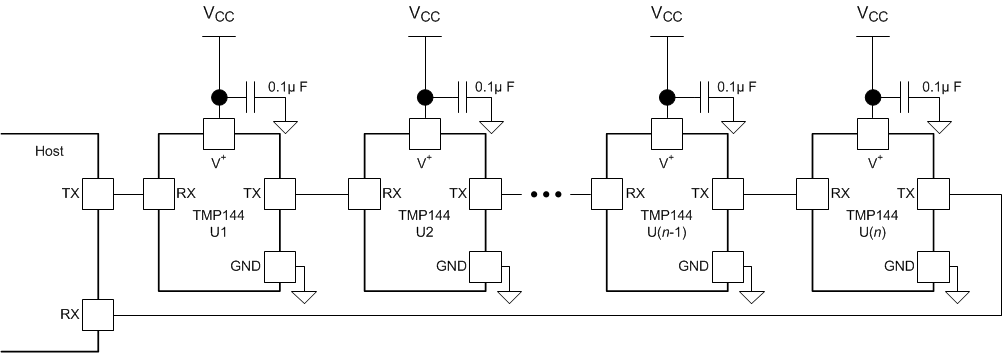SBOS891C October 2018 – September 2023 TMP144
PRODUCTION DATA
- 1
- 1 Features
- 2 Applications
- 3 Description
- 4 Revision History
- 5 Pin Configuration and Functions
- 6 Specifications
- 7 Detailed Description
- 8 Application and Implementation
- 9 Device and Documentation Support
- 10Mechanical, Packaging, and Orderable Information
Package Options
Refer to the PDF data sheet for device specific package drawings
Mechanical Data (Package|Pins)
- YBK|4
- YFF|4
- YMT|4
Thermal pad, mechanical data (Package|Pins)
Orderable Information
3 Description
The TMP144 digital output temperature sensor can read temperatures to a resolution of 0.0625°C.
The device has a SMAART Wire™ / UART interface that supports daisy-chain configurations. The interface also supports Multiple Device Access (MDA) commands that let the host communicate with multiple devices on the bus simultaneously. MDA commands are used as an alternative to sending individual commands to each device on the bus. Up to 16 TMP144 devices can be attached together serially and can be read by the host computer.
The TMP144 device is designed for space-constrained, power-sensitive applications with multiple temperature measurement zones that must be monitored. The device is specified for operation over a temperature range of –40°C to 125°C and is available in three different 4-ball, low-height wafer chip-scale package (DSBGA) options. The YMT package of the device has a height of 150 µm, which is 40% thinner than a 0201 resistor. The thinner YMT package can be placed under heat-dissipating components on the system for better accuracy and faster thermal response times.
| PART NUMBER | PACKAGE | PACKAGE SIZE (NOM)(2) |
|---|---|---|
| TMP144 | YFF (DSBGA, 4) | 0.76 mm × 0.96 mm |
| YMT (DSBGA, 4) | 0.76 mm × 0.96 mm | |
| YBK (DSBGA, 4) | 0.76 mm × 0.96 mm |
